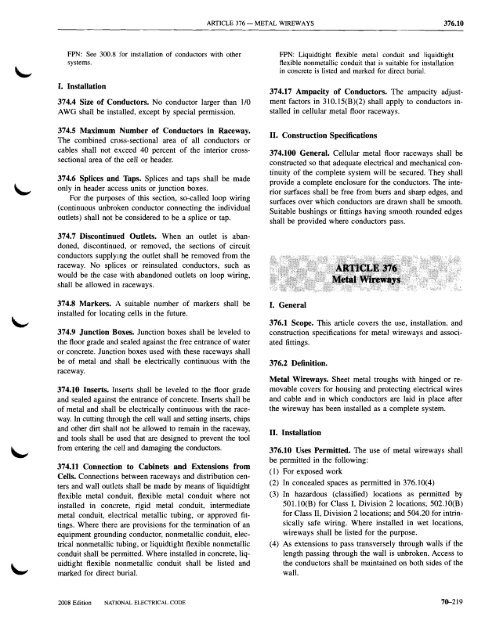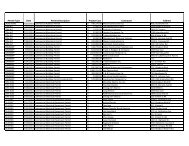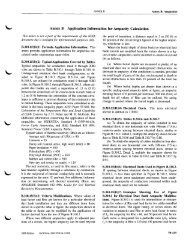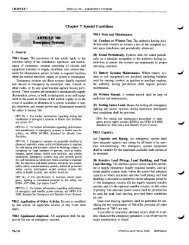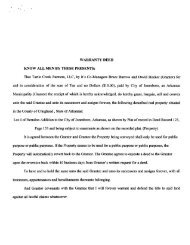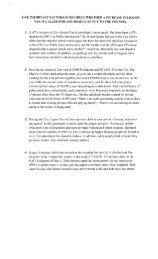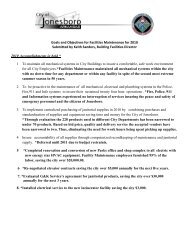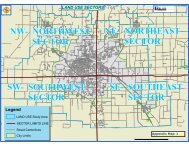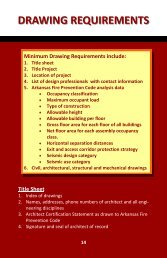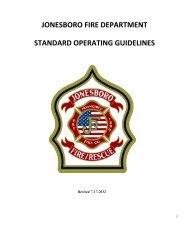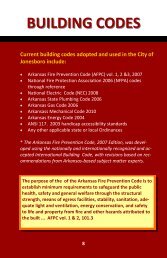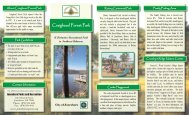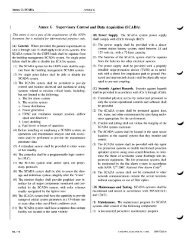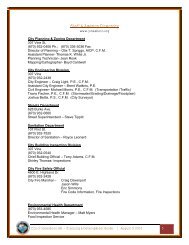Chapter 3 Wiring Methods and Materials
Chapter 3 Wiring Methods and Materials
Chapter 3 Wiring Methods and Materials
Create successful ePaper yourself
Turn your PDF publications into a flip-book with our unique Google optimized e-Paper software.
ARTICLE 376 -<br />
METAL WlREWAYS<br />
376.10<br />
FPN: See 300.8 for installation of conductors with other<br />
systems.<br />
I. Installation<br />
374.4 Size of Conductors. No conductor larger than 110<br />
AWG shall be installed, except by special permission.<br />
374.5 Maximum Number of Conductors in Raceway.<br />
The combined cross-sectional area of all conductors or<br />
cables shall not exceed 40 percent of the interior crosssectional<br />
area of the cell or header.<br />
374.6 Splices <strong>and</strong> Taps. Splices <strong>and</strong> taps shall be made<br />
only in header access units or junction boxes.<br />
For the purposes of this section, so-called loop wiring<br />
(continuous unbroken conductor connecting the individual<br />
outlets) shall not be considered to be a splice or tap.<br />
FPN: Liquidtight flexible metal conduit <strong>and</strong> liquidtight<br />
flexible nonmetallic conduit that is suitable for installation<br />
in concrete is listed <strong>and</strong> marked for direct burial.<br />
374.17 Ampacity of Conductors. The ampacity adjustment<br />
factors in 31O.15(B)(2) shall apply to conductors installed<br />
in cellular metal floor raceways.<br />
II. Construction Specifications<br />
374.100 General. Cellular metal floor raceways shall be<br />
constructed so that adequate electrical <strong>and</strong> mechanical continuity<br />
of the complete system will be secured. They shall<br />
provide a complete enclosure for the conductors. The interior<br />
surfaces shall be free from burrs <strong>and</strong> sharp edges, <strong>and</strong><br />
surfaces over which conductors are drawn shall be smooth.<br />
Suitable bushings or fittings having smooth rounded edges<br />
shall be provided where conductors pass.<br />
374.7 Discontinued Outlets. When an outlet is ab<strong>and</strong>oned,<br />
discontinued, or removed, the sections of circuit<br />
conductors supplying the outlet shall be removed from the<br />
raceway. No splices or reinsulated conductors, such as<br />
would be the case with ab<strong>and</strong>oned outlets on loop wiring,<br />
shall be allowed in raceways.<br />
374.8 Markers. A suitable number of markers shall be<br />
installed for locating cells in the future.<br />
374.9 Junction Boxes. Junction boxes shall be leveled to<br />
the floor grade <strong>and</strong> sealed against the free entrance of water<br />
or concrete. Junction boxes used with these raceways shall<br />
be of metal <strong>and</strong> shall be electrically continuous with the<br />
raceway.<br />
374.10 Inserts. Inserts shall be leveled to the floor grade<br />
<strong>and</strong> sealed against the entrance of concrete. Inserts shall be<br />
of metal <strong>and</strong> shall be electrically continuous with the raceway.<br />
In cutting through the cell wall <strong>and</strong> setting inserts, chips<br />
<strong>and</strong> other dirt shall not be allowed to remain in the raceway,<br />
<strong>and</strong> tools shall be used that are designed to prevent the tool<br />
from entering the cell <strong>and</strong> damaging the conductors.<br />
374.11 Connection to Cabinets <strong>and</strong> Extensions from<br />
Cells. Connections between raceways <strong>and</strong> distribution centers<br />
<strong>and</strong> wall outl,:;:ts shall be made by means of liquidtight<br />
flexible metal conduit, flexible metal conduit where not<br />
installed in concrete, rigid metal conduit, intermediate<br />
metal conduit, electrical metallic tubing, or approved fittings.<br />
Where ther,:;: are provisions for the termination of an<br />
equipment grounding conductor, nonmetallic conduit, electrical<br />
nonmetallic tubing, or liquidtight flexible nonmetallic<br />
conduit shall be permitted. Where installed in concrete, liquidtight<br />
flexible nonmetallic conduit shall be listed <strong>and</strong><br />
marked for direct burial.<br />
I. General<br />
376.1 Scope. This article covers the use, installation, <strong>and</strong><br />
construction specifications for metal wireways <strong>and</strong> associated<br />
fittings.<br />
376.2 Definition.<br />
Metal Wireways. Sheet metal troughs with hinged or removable<br />
covers for housing <strong>and</strong> protecting electrical wires<br />
<strong>and</strong> cable <strong>and</strong> in which conductors are laid in place after<br />
the wireway has been installed as a complete system.<br />
II. Installation<br />
376.10 Uses Permitted. The use of metal wireways shall<br />
be permitted in the following:<br />
(1) For exposed work<br />
(2) In concealed spaces as permitted in 376.10(4)<br />
(3) In hazardous (classified) locations as permitted by<br />
501.10(B) for Class I, Division 2 locations; 502.1O(B)<br />
for Class II, Division 2 locations; <strong>and</strong> 504.20 for intrinsically<br />
safe wiring. Where installed in wet locations,<br />
wireways shall be listed for the purpose.<br />
(4) As extensions to pass transversely through walls if the<br />
length passing through the wall is unbroken. Access to<br />
the conductors shall be maintained on both sides of the<br />
wall.<br />
2008 Edition NATIONAL ELECTRICAL CODE 70-219


